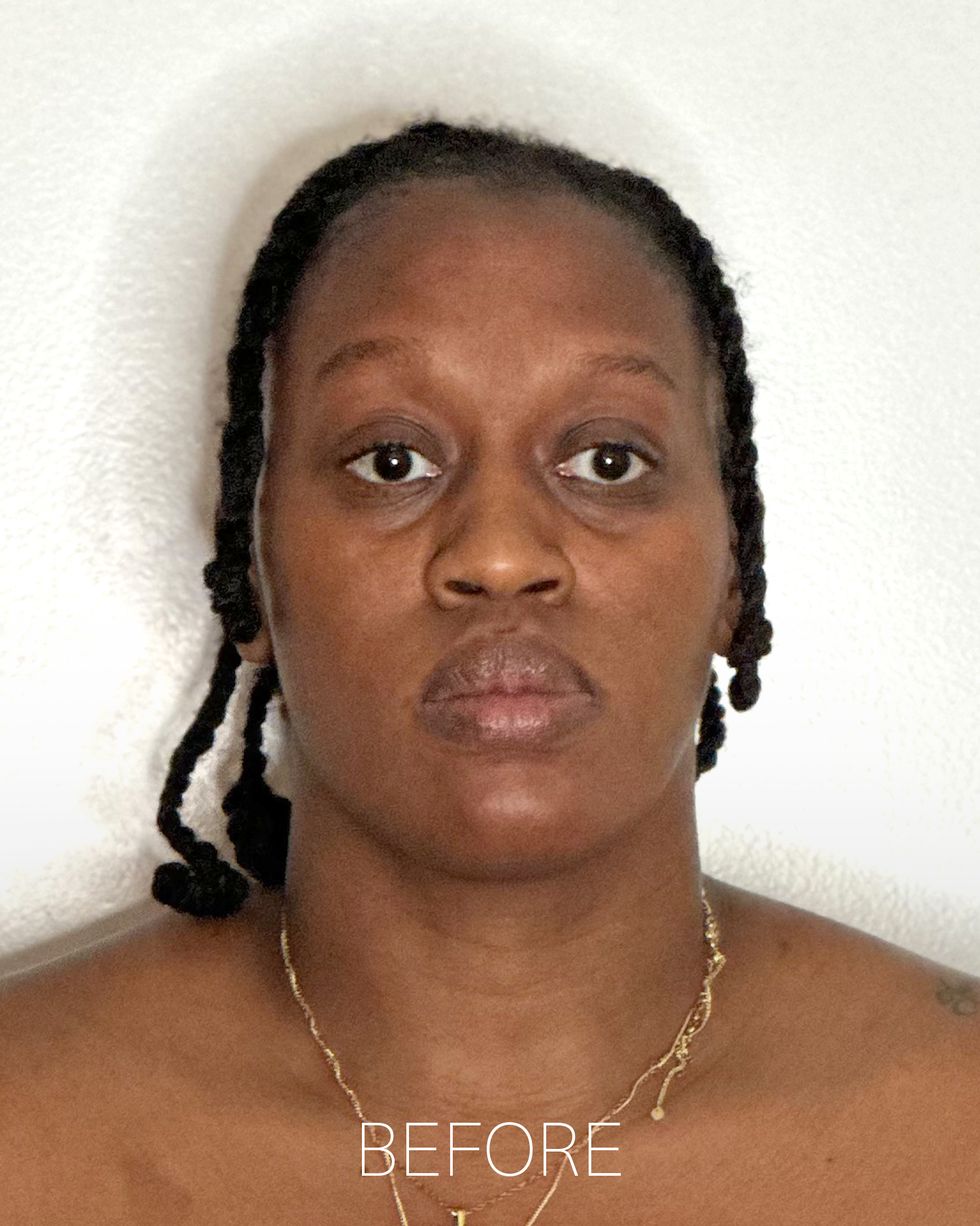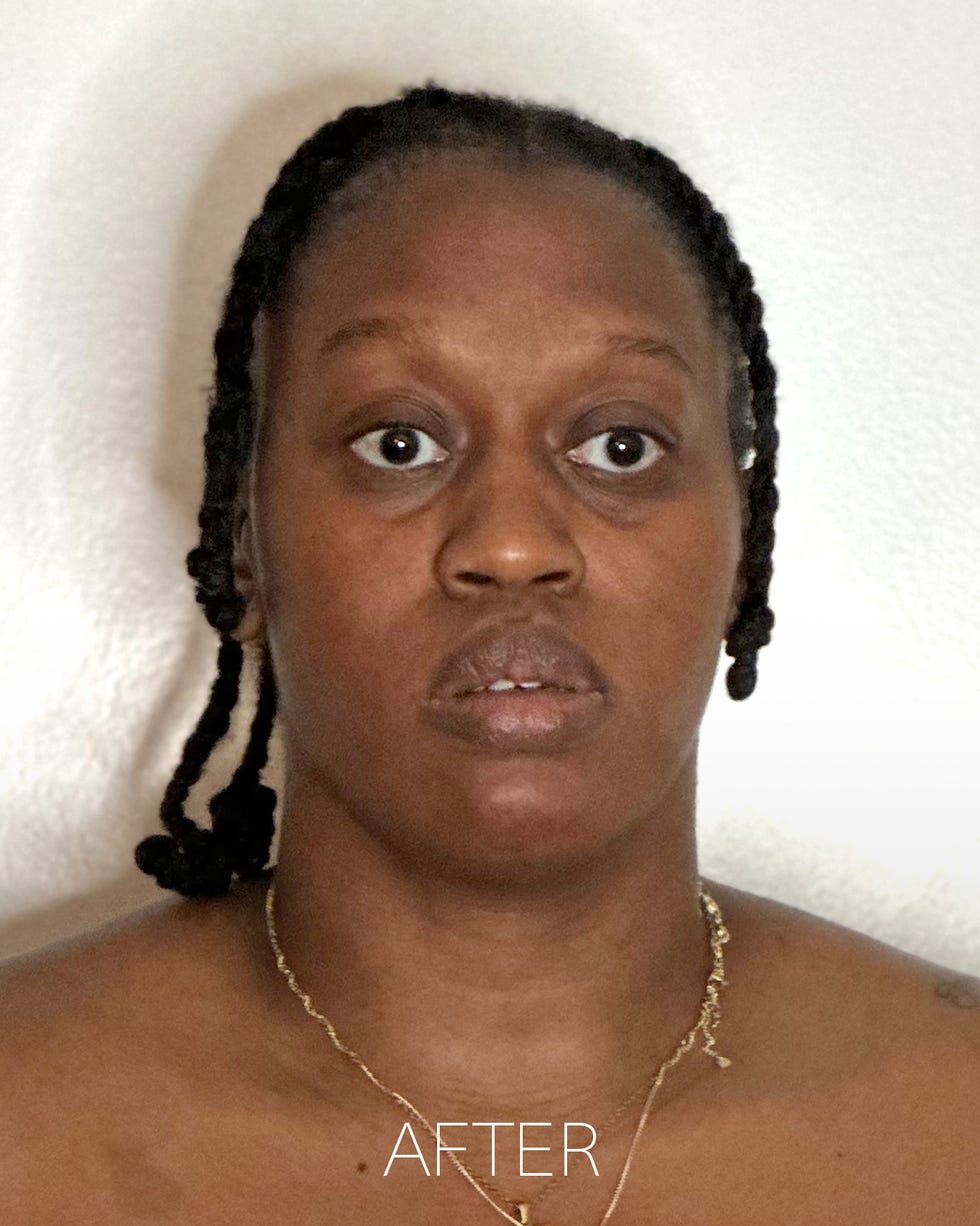Mora Adeyi, a psychotherapist and adjunct professor at Columbia, said her face has changed a lot over the last three years. The 35-year-old told ELLE.com that when she looks at pictures of herself before 2020 and compares them to the woman she sees in the mirror today, she can’t help but notice the wear and tear on her skin. She said at one point during the COVID-19 pandemic, her caseload was stacked with 50 patients a week. “I was dealing with a lot of patients who were experiencing the death of their loved ones, the death of their partners, the death of family,” Adeyi told ELLE.com. According to Adeyi, her profession now shows up on her face as lines, dark circles, and puffiness. While Adeyi said she’s managed to maintain a pretty steady and rigorous skin routine through it all, she knew to see real change, she would have to try something new: So she tried a fascia facial.
Facials have been a long-held staple in any regular beauty routine, but some holistic health practitioners say fascia facials can take the benefits of your average facial even deeper. A fascia facial is a form of myofascial release that treats the face and shoulders by using massage to manipulate the fascia, the invisible network of connective tissue covering muscle underneath the skin. “Myofascial release is essentially an advanced massage technique thought to break up constricted fascia. This is not limited to the face, and a good example is people using a foam roller after exercise,” Dr. Chinedu O. Nwasike, MD, an orthopedic surgeon based in Las Vegas, told ELLE.com. Physical and emotional trauma, tension, and stress can impact the fascia, which can manifest on the face as lines, wrinkles, displaced facial features, and puffiness, according to skin care experts who spoke to ELLE.com. Brittany Trent, an NYC licensed esthetician, told ELLE.com that fascia facials “act like a natural facelift because it stimulates these muscles in your face that increase the collagen production and boost the elasticity.” Trent said while your regular facial addresses more surface-level concerns like rough skin, hyperpigmentation, and hydration, fascia facials take the healing benefits a step further by encouraging lymphatic drainage, which is the body system responsible for carrying excess fluid and waste out of our tissues (which can cause puffiness/swelling) and into our bloodstream. Adeyi, curious about the benefits of the treatment herself, went to Calm Beauty Brooklyn to receive a fascia facial from its founder, Joanna Tringali, a NYC-based holistic esthetician, massage therapist, and facial massage educator with over 30 years of experience. Tringali described the fascia as “living, breathing tissue” connected to our nervous system that expands and contracts depending on how much moisture is in the tissue. “My goal is to get that fascia moving, which means nutrients will flow into it from the blood, from the lymph, because once that fascia tightens up, that circulation is impeded,” Tringali said.
One of the ways healthy blood circulation of the fascia can be compromised is through the impact of trauma. Dr. Rene Stokes, a Board Certified Adult and Child Psychiatrist with special training in nutritional psychiatry and the cellular impact of stress and trauma, told ELLE.com that traumatic experiences and chronic stress can lead to chronic inflammation, which can accelerate signs of aging like fine lines and wrinkles. Dr. Stokes explained that our bodies have a built-in system designed to mount a response to a safety threat: the autonomic nervous system. When this system is healthy, the body can vacillate between fight, flight, freeze, and recovery, rest, and digest, many times throughout the day. But trauma throws that system out of whack, and the body basically gets stuck in chronic activation or deactivation mode. “Historically, threats meant like a lion was trying to eat you and kill you. These days, it can be a big meeting at work or being bullied at school,” Dr. Stokes said. When the body is mounting a response against a threat, it activates skeletal muscles and deprioritizes digestion and nutrient absorption to prioritize running away from a threat or fighting it. “All of a sudden you have all this skeletal muscle activation. Where does that go when there’s no lion? Where does that go when you’re just sitting at your desk? That turns into muscle tension,” she said. So the muscles can, in effect, become frozen in time, locked in a state of threat response, which is what the fascia specialists work on, she said.
Tringali said that as our bodies are impacted by psychological or physical pain, our face moves in response to our emotions and feelings. “Our face is the most emotive part of our whole body, as its muscles are designed as small flat tissues that directly reflect what you’re feeling,” she said. She said wrinkling between the brows or widening of the jaw can be signs of contracted face muscles, impacted by stress or trauma. For that reason, Tringali said that while clients will come in for treatment for surface beauty reasons, they often leave with so much more. Over a course of a few sessions, clients will start to notice improvements to their skin, like less wrinkles, balanced eyes, more sculpted chin or cheeks, or even ease of mouth opening and closing, Tringali said. “Because the fascia has been manipulated and emotions that were stuck in the fascia have now been acknowledged, there’s just this freer motion,” Tringali said.
When Adeyi finished her treatment, she described her experience as “otherworldly.” She said throughout the massage, Tringali was focused on loosening the tightness in her jaw on each side of her face. “I felt like my face looked physically different, but I also felt a mental clarity that I had not felt in years. And I was like, now what is this?” Adeyi said. Adeyi said Tringali pointed out the tension she was holding on the left side of her body in particular, which she said was potentially unprocessed grief. “I did suffer a loss during COVID. I lost my grandfather,” Adeyi said. “I don’t necessarily feel like I properly made space to process his death,” she said, adding, “We talk about soft girl life, and I feel like that has not been accessible to me because of the line of work I’m in.” From just one treatment, Adeyi said she saw improvement in jawline definition, skin tone due to increased blood circulation, and softened lines.
For folks interested in fascia facials, it’s important to mention that the best results happen over time. Repeated treatment helps the body reprogram itself out of a chronic state of muscle spasm and tension. “Depending on the severity of the issue(s), I may recommend six to 10 sessions. The six sessions are generally once per week for a total of 6 weeks,” Trigali said. The cost of individual sessions run anywhere from $250-$350.
After the series, maintenance is recommended, which can be monthly, then taper off when awareness is built, according to Trigali. She said she gives her clients “homework” where they do facial yoga and journaling to explore their emotions or skin issues, which she said contributes to long-term change. She said procedures like Botox, which use purified bacterium to freeze muscles into place to temporarily reduce the appearance of fine lines and wrinkles, are basically just throwing a bandaid on a larger problem. “The emotion has not been dealt with, and you are literally paralyzing a muscle with a toxin in hopes that your face won’t wrinkle, which is ridiculous,” she said. Tringali said that over time, the skin will sag again, and she said she’s had to do rehabilitation work on clients whose muscles have withered or whose fascia has become brittle due to injections. Tringali said while aging is a natural process, premature aging can be a sign of underlying issues, so pay attention to your emotional and physical health if lines and wrinkles appear earlier than expected. She said sometimes, spectator comments like, “You look tired” or “You don’t look like yourself lately,” can be hard to hear, but they could be a signpost that your face is storing trauma and stress.
Research on the longterm benefits of fascia release has yet to catch up to the claims of holistic medicine practitioners and their patients’ anecdotes. Dr. Nwasike said that emotional trauma, on the osteopathic side of medicine, is believed to weaken fascia as the body’s response to the trauma. But myofascial release itself has actually not been shown in any high-level studies to be beneficial, according to Dr. Nwasike. However, that doesn’t rule the treatment completely out.
“I tell my patients it does not hurt to try these techniques as long as the person doing it is trained,” Dr. Nwasike said. Dr. Stokes said there is an important role fascia massagists can play in an entire wellness package, which could include a functional medicine psychiatrist or functional medicine provider, a therapist, a functional nutritionist, and even a trainer. Stokes said it’s important for a person’s care team to look at the other inputs for wellness that are missing outside of what’s showing up aesthetically, and assess history of trauma, nutrition, and social connectedness, which are key ingredients for a healthy life. “When people say ‘we hold trauma in the body,’ it’s not just our memory of it,” Dr. Stokes said. “We also have to recalibrate all the systems that have been impacted by the trauma, too.”
Keyaira Kelly is a writer, editor, and poet based in New York & Los Angeles. Her work lives and breathes at the intersection of pop culture and wellness. She formerly served as Health Editor at Business Insider, with bylines scattered across the web for other outlets including ESSENCE, HelloBeautiful, The Grio, and The World Economic Forum. She prefers her wee dog and sci-fi books over people most days, unless someone’s throwing a really good party. Follow her incense trail @keyairakelly on IG.



